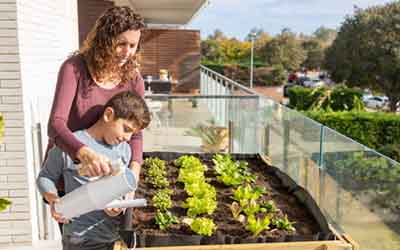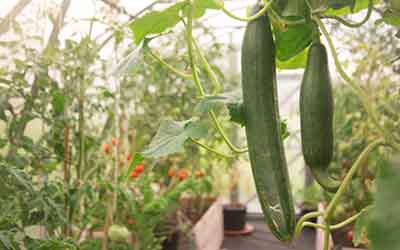Are you among the curious person interested to know about the best fruits and vegetables to grow on a balcony? Worry no more, I am here for you. In today’s rapidly urbanizing world, concrete jungles have increasingly overshadowed the lush green landscapes we once knew.
High-rise buildings and congested streets dominate our views. Amidst this change, many urban dwellers are yearning for a touch of nature – a piece of verdant land to call their own.
This has given rise to the trend of balcony gardening, a testament to the human spirit’s adaptability and our intrinsic connection to the earth.
Growing your own produce isn’t merely a pastime reserved for those with expansive backyards or community garden plots. Even the tiniest balconies can transform into thriving green oases with the right approach. Imagine stepping out of your living room and plucking a ripe strawberry or snipping fresh lettuce for a salad; it’s not just about the produce but the profound sense of accomplishment that comes with it.
The benefits of balcony gardening extend beyond the plate. Cultivating a mini garden on your balcony can enhance mental well-being, provide a relaxing escape from the daily urban hustle, and even act as an educational tool for younger family members.
Furthermore, in an era where the source of our food is becoming a pressing concern, what could be more reassuring than knowing your fruits and vegetables come from a place of love and care – your own balcony?
As we proceed into the world of balcony gardening, we’ll explore the best fruits and vegetables that thrive in such settings, ensuring even the most novice gardener can find success.
Whether you’re looking to supplement your meals, save on grocery bills, or simply create a serene spot to enjoy your morning coffee, balcony gardening holds the promise for all this and more.
The Basics of Balcony Gardening
The Importance of Sunlight, Soil Quality, and Container Sizes in balcony gardening cannot be over-estimated.
Sunlight
Every budding gardener must first recognize the power of the sun. The majority of fruits and vegetables crave a good amount of sunlight – typically 6-8 hours daily. When planning your balcony garden:
- Assess Your Sunlight: Track how many hours of direct sunlight your balcony receives each day. This will guide your plant choices, as some require full sun, while others can tolerate partial shade.
- Positioning is Key: Once you know your balcony’s sunlight pattern, position your plants accordingly. Those requiring more sunlight should be placed in the sunniest spots.
Soil Quality
In balcony gardening, the soil acts as the foundation of your green sanctuary. Since natural ground isn’t an option:
- Opt for Quality Potting Mix: This mix is designed to retain moisture while providing adequate drainage, essential for potted plants. It also ensures roots get the right nutrients.
- Consider Organic Compost: Enrich your potting mix with organic compost to boost its nutrient content and support plant growth.
Container Sizes
Your plants’ homes are just as crucial as the plants themselves.
- Match Plant to Pot: Some vegetables, like carrots, need depth to grow, while others, like lettuce, require more surface area. Research each plant’s requirements and choose pots accordingly.
- Material Matters: While plastic pots are lightweight and retain moisture, clay pots (like terracotta) are breathable, promoting better root health. The choice depends on the plant’s needs and your personal aesthetic preference.
Watering and Drainage Essentials for Balcony Plants
In the realm of gardening, water is life – but only when given in the right amounts.
Therefore, it remains of utmost importance to develop a regular watering routine, as inconsistent watering can stress plants.
Watering in the early morning allows plants to absorb moisture before the midday sun causes evaporation. Too much water can lead to root rot. Use a finger test: if the top inch of soil is dry, it’s time to water.
In the same vain, ensure every pot has adequate drainage holes. This prevents excess water from stagnating at the bottom.
Place trays or saucers beneath pots to catch excess water, preventing balcony staining and aiding in moisture retention.
Advantages of Vertical Gardening to Maximize Space
Vertical gardening is a game-changer for those with space constraints. It refers to the strategy of growing plants upwards rather than outwards.
Why Go Vertical?
- Space-Saving
Vertical structures, such as trellises or wall-mounted planters, allow for more plants in less square footage.
- Aesthetic Appeal
Vertical gardens can act as living art, adding a dynamic visual element to your balcony.
- Better Air Circulation
Elevating some plants can enhance air circulation, reducing the risk of fungal diseases.
- Easier Access
For many gardeners, tending to plants at waist or eye level can be more comfortable than constantly bending down.
Best fruits and vegetables to grow on a balcony
See below;
Best Fruits to Grow on a Balcony
- Strawberries
- Tomatoes
- Peppers (Bell Peppers & Chili Peppers):
- Blueberries
Strawberries
Varieties Suited for Pots and Hanging Baskets:

- Alpine Strawberries: Compact and bushy, they’re perfect for containers and produce small, aromatic fruits.
- Day-Neutral Varieties: Such as ‘Tribute’ or ‘Tristar’, these produce fruit throughout the growing season and are well-suited for hanging baskets.
Care and Harvest Tips:
- Sunlight Needs: Strawberries prefer full sun, with at least 6-8 hours daily.
- Watering: Keep the soil consistently moist but not soggy. Overwatering can lead to root rot.
- Harvesting: Pick strawberries when they are fully red. To harvest, pinch off the stem, not the berry, to prevent bruising.
Tomatoes
Difference between Determinate and Indeterminate Types:

- Determinate (Bush) Tomatoes: These plants grow to a certain height and then stop, producing all their fruit at once. Varieties like ‘Patio Princess’ and ‘Tidy Treats’ are ideal for pots.
- Indeterminate (Vine) Tomatoes: They continue growing and producing fruit throughout the season. ‘Tiny Tim’ and ‘Balcony’ are popular indeterminate varieties for containers.
Best Pot Size and Staking Techniques:
- Pot Size: At least 5 gallons for determinate tomatoes and 10 gallons for indeterminate ones.
- Staking: Use stakes, cages, or trellises to support growing plants and prevent them from sprawling. This also ensures fruits don’t touch the soil, reducing rot risks.
Peppers (Bell Peppers & Chili Peppers)
Sunlight and Watering Needs:
- Sunlight: Peppers love the sun. Aim for 6-8 hours of direct sunlight daily.
- Watering: Water when the top inch of the soil feels dry. Consistency is vital to prevent flower drop.
Ideal Soil Mix:
- Well-draining Potting Mix: This is crucial to prevent root rot.
- Enrich with Compost: A mix enriched with organic compost will provide the nutrients peppers need to flourish.
Blueberries
Soil pH Importance and Container Size:
- Soil pH: Blueberries thrive in acidic soil. Aim for a pH level between 4.5 and 5.5. You can achieve this by using a specific acid-loving plant mix or adding sulfur to regular potting soil.
- Container Size: A 12-18 inch diameter pot is ideal for most varieties.
Benefits of Having Multiple Plants:
- Cross-Pollination: Having at least two different blueberry varieties can increase yield due to cross-pollination.
- Extended Harvest: Different varieties ripen at different times, allowing for a longer harvest period.
Best Vegetables to Cultivate on a balcony
- Lettuce & Salad Greens
- Radishes
- Carrots
- Green Onions (Scallions)
Lettuce & Salad Greens
Benefits of Cut-and-Come-Again Varieties:

- Continuous Harvest: These varieties, such as loose-leaf lettuce, allow gardeners to harvest outer leaves while the plant continues to grow, ensuring a longer harvesting period.
- Space-Efficient: Since you’re frequently harvesting, plants stay manageable in size, making them ideal for balcony gardens.
Frequent Harvesting Tips:
- Mature Leaves: Always pick mature leaves from the outside, allowing younger, inner leaves to continue growing.
- Use Scissors: Snipping leaves with scissors can be gentler than pulling, which can disturb roots.
Radishes
Short Growth Cycle and Space-Saving Tips:
- Swift Harvest: Most radish varieties mature within 20-30 days, making them one of the quickest balcony crops.
- Utilize Space: Due to their small size and fast growth, radishes can be interplanted with slower-growing vegetables, maximizing the use of space.
Companion Planting Suggestions:
- Pair with Carrots: Radishes can break the soil for carrot seeds, which take longer to germinate.
- Avoid Cruciferous Veggies: Such as broccoli or cauliflower, as they compete for the same nutrients.
Carrots
Varieties Suitable for Pots:
- ‘Parisian’: A round, bite-sized carrot perfect for shallow pots.
- ‘Short ‘N Sweet’: As the name suggests, they’re shorter in length, making them suitable for container gardening.
Soil Depth Importance:
- Deep Containers: For traditional long carrots, choose deep containers that allow roots to expand. A depth of at least 10-12 inches is recommended.
- Loose and Sandy Soil: Carrots grow best in a loose, sandy potting mix, which allows their roots to expand without resistance.
Green Onions (Scallions)
Re-growing from Kitchen Scraps:

- Reuse Roots: After using the green part, the white root end (with a small amount of green) can be planted. In a few weeks, you’ll have a new set of green onions.
- Continuous Supply: By re-growing multiple scraps, you can have an endless supply from just a few initial purchases.
Successive Planting for a Steady Supply:
- Staggered Planting: Instead of planting all your seeds or bulbs at once, space out your plantings every week. This ensures you always have mature onions ready to harvest while others are still growing.
Essential Tips for Balcony Garden Success
See below;
Picking the Right Container Sizes and Materials
Choosing the appropriate container size is vital for the plant’s growth. A pot that’s too small can restrict root growth, while an overly large pot can retain excessive moisture, potentially harming the plant.
- Deep Roots: For plants like tomatoes or carrots, opt for deeper containers that allow roots to stretch comfortably.
- Shallow Roots: Plants like lettuce and herbs can thrive in shallower containers.
- Clay and Terracotta: These are breathable, which means they allow water and air to pass through, promoting root health. However, they can dry out quickly in hot climates.
- Plastic and Resin: Lightweight and retaining moisture well, they’re great for balconies with weight restrictions. Ensure they have proper drainage holes.
Ensuring Good Drainage
Adequate drainage prevents water from pooling at the bottom of containers, reducing the risk of root rot.
- Drainage Holes: Always choose pots with drainage holes. If your chosen pot doesn’t have them, carefully drill some yourself.
- Elevate Pots: Using pot feet or even wooden blocks can aid drainage and prevent the base from becoming waterlogged.
- Pebble Layer: Adding a layer of pebbles or small stones at the bottom of a pot can improve drainage.
Using Quality Potting Mix and Organic Fertilizers: Feeding Your Green Companions
Regular garden soil is often too dense for container plants.
- Potting Mix: This is specifically formulated for containers, providing the right texture and nutrients for potted plants.
- Organic Compost: Mixing in organic compost can enhance the nutrient content of your soil.
- Organic Fertilizers: They release nutrients slowly and improve soil structure. Options like worm castings, seaweed extract, or fish emulsion are excellent choices.
- Balanced Feeding: Ensure the fertilizer offers a balanced N-P-K (nitrogen, phosphorus, potassium) ratio, suitable for the specific plants you’re growing.
Regular Monitoring for Pests and Diseases
Regularly inspecting your plants can catch problems early, making them easier to address.
- Common Pests: Aphids, spider mites, and whiteflies can be common on balcony gardens. If spotted early, a simple spray of soapy water can be an effective remedy.
- Disease Watch: Yellowing leaves, black spots, or mold indicate potential diseases. Remove affected parts and ensure good airflow to keep plants healthy.
- Neem Oil: This natural insect repellent can deter many pests when sprayed as a preventive measure.
- Healthy Soil: Diseases often find it hard to take root in well-nourished, balanced soil. Regularly enriching your soil with compost can be a strong defensive tactic.
My balcony garden experience
I’ll never forget the first tomato I harvested from my balcony garden. It was a vibrant shade of red, perfectly round, and gleaming with morning dew. I was overwhelmed with a sense of pride.
Months of care, from selecting the right container to monitoring its growth, had led to this moment. As I sliced into it, the rich aroma wafted up, instantly transporting me back to memories of my grandmother’s backyard garden.
The taste was unparalleled, sweet, tangy, and bursting with flavors. This was not just a tomato; it was a testament to patience, love, and nature’s incredible magic.
You too can do the same and have this memorable moment. Every gardener, be it a seasoned expert or a budding enthusiast, has a story to tell. From the first sprout that peeked through the soil to the joyous moment of the first harvest, every journey is unique and inspiring.
Concluding remark on Best fruits and vegetables to grow on a balcony
in recent time, balcony gardening emerges as a testament to our human connection with nature, a reminder that even in the most confined spaces, we can cultivate our own green haven.
As we explored the best fruits and vegetables for balcony gardening, we unveiled a world of possibilities waiting to be sown and harvested.
From the tangy sweetness of homegrown strawberries to the succulent crunch of balcony-grown radishes, these choices not only nourish our bodies but also feed our souls. Balcony gardening isn’t just about the produce; it’s about the journey, the connection, and the joys of nurturing life.
Recommendations
What is the green revolution in agriculture?
Environmental benefits of urban farming
Does companion planting tomatoes and basil work?



